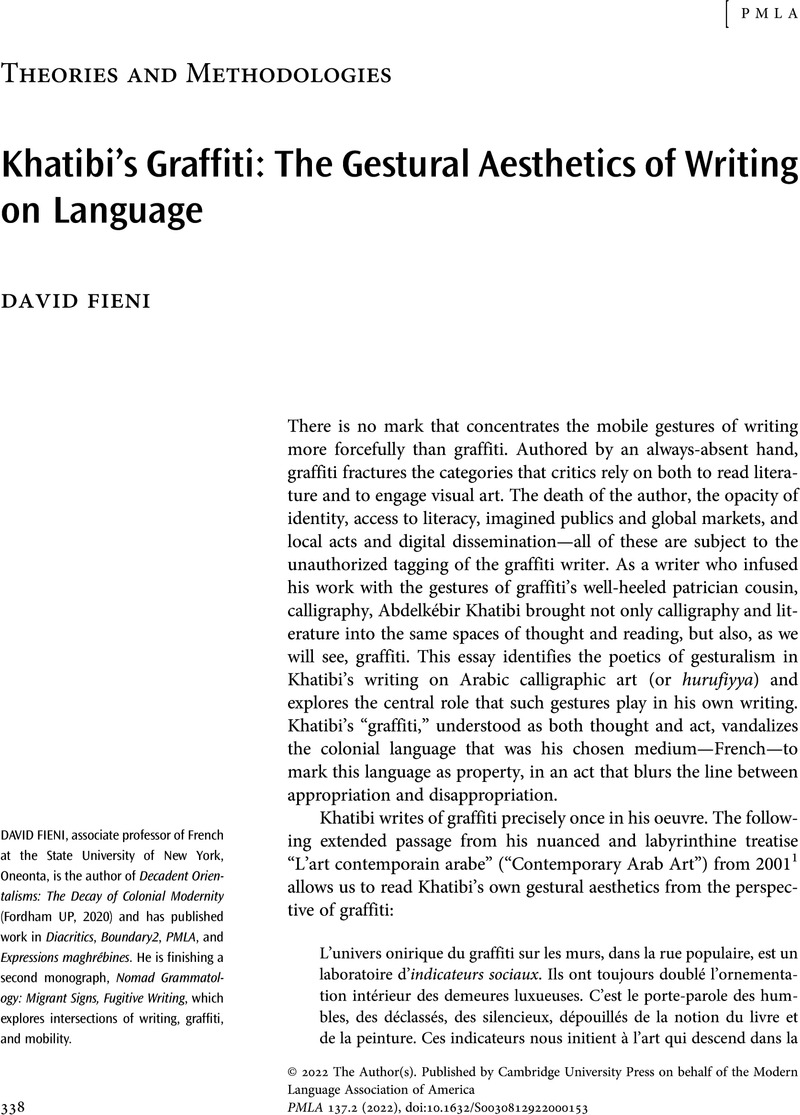No CrossRef data available.
Article contents
Khatibi's Graffiti: The Gestural Aesthetics of Writing on Language
Published online by Cambridge University Press: 25 May 2022
Abstract
An abstract is not available for this content so a preview has been provided. Please use the Get access link above for information on how to access this content.

- Type
- Theories and Methodologies
- Information
- Copyright
- Copyright © 2022 The Author(s). Published by Cambridge University Press on behalf of the Modern Language Association of America
References
Works Cited
Ahmady, Leeza, et al. Tarjama/Translation: Contemporary Art from the Middle East, Central Asia, and Their Diasporas. ArteEast, 2009.Google Scholar
Al-Kassim, Dina. On Pain of Speech: Fantasies of the First Order and the Literary Rant. U of California P, 2010.Google Scholar
Defert, Jacques. De la possession au bricolage prophétique: Changement social, folie et manipulation individuelle inédite des représentations traditionnelles à Fès au Maroc: Le parcours d'Abdellah “Grillo.” 1982. École des Hautes Études en Sciences Sociales, PhD dissertation.Google Scholar
Defert, Jacques. “Une topographie transgressive.” Cartes et figures de la terre: Exposition présentée au Centre Georges Pompidou du 24 mai au 17 novembre 1980. Centre Georges Pompidou / Centre de création industrielle, 1980, pp. 191–93.Google Scholar
Deleuze, Gilles. Difference and Repetition. Translated by Patton, Paul, Columbia UP, 1994.Google Scholar
Dubreuil, Laurent, and Fieni, David, editors. Abdelkébir Khatibi, intersigne, special issue of Expressions maghrébines, vol. 12, no. 1, 2013.Google Scholar
Fieni, David. Decadent Orientalisms: The Decay of Colonial Modernity. Fordham UP, 2020.Google Scholar
Fieni, David. “Mobile and Captive Geometries: From Hurufiya to Video in Abdelkébir Khatibi, Mounir Fatmi, and Bouchra Khalili.” Expressions maghrébines, vol. 19, no. 1, 2020, pp. 33–47.CrossRefGoogle Scholar
Fieni, David. “What a Wall Wants, or How Graffiti Thinks: Nomad Grammatology in the French Banlieue.” Diacritics, vol. 40, no. 2, 2012, pp. 72–93.Google Scholar
Genet, Jean. Prisoner of Love. Translated by Bray, Barbara, New York Review Books, 2003.Google Scholar
Khalili, Bouchra. The Typographer. Bouchra Khalili, bouchrakhalili.com/the-typographer-16mm-film-2019.Google Scholar
Khatibi, Abdelkébir. “L'art contemporain arabe: Prolégomènes.” Œuvres complètes III: Essais, La Différence, 2001, pp. 261–95.Google Scholar
Khatibi, Abdelkébir. “Bilingualism and Literature.” Plural Maghreb: Writings on Postcolonialism, translated by Burcu Yalim, P., Bloomsbury, 2019, pp. 117–40.Google Scholar
Khatibi, Abdelkébir. “Bilinguisme et littérature.” Maghreb pluriel, Éditions de Noël, 1983, pp. 179–207.Google Scholar
Khatibi, Abdelkébir. “Envol des racines.” Maghreb pluriel, Éditions de Noël, 1983, pp. 212–26.Google Scholar
Khatibi, Abdelkébir. “Flight of the Roots.” Plural Maghreb: Writings on Postcolonialism, translated by Burcu Yalim, P., Bloomsbury, 2019, pp. 141–52.Google Scholar




